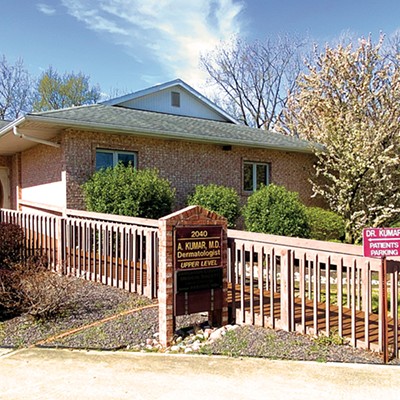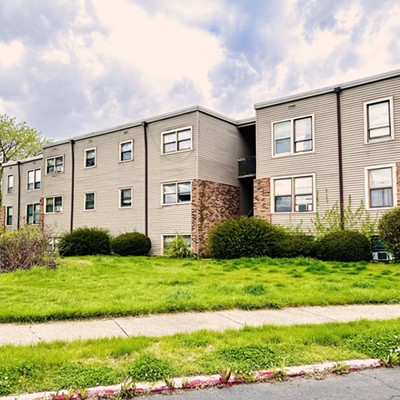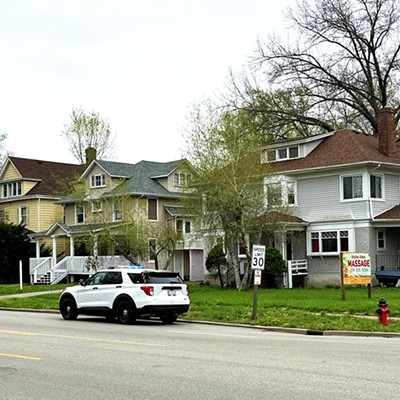Window panes and the state’s fiscal pain
[
{
"name": "Air - MedRect Combo - Inline Content 1",
"component": "11490391",
"insertPoint": "3",
"requiredCountToDisplay": "1",
"parentWrapperClass": "fdn-ads-inline-content-block"
},{
"name": "Air - MedRect Combo - Inline Content 2",
"component": "11490392",
"insertPoint": "7",
"requiredCountToDisplay": "5",
"parentWrapperClass": "fdn-ads-inline-content-block"
},{
"name": "Air - MedRect Combo - Inline Content 3",
"component": "11490393",
"insertPoint": "12",
"requiredCountToDisplay": "9",
"parentWrapperClass": "fdn-ads-inline-content-block"
}
]
I was a painter in my younger days. With my dad, uncle and brother, we maintained many of the buildings in the Sangamon Valley back in the forties. I started when I was 17, making 50 cents an hour and working a 10-hour day.
I remember the Taylor place. The rest of the crew were putting insulated siding on the old tenant house. It was for me to paint the windows. They were six-over-six double-hung sash with twelve 14-inch by 16-inch panes of glass. Because of the recent war and the shortages, they hadn’t been painted for several years. The putty was loose and much of the putty had to be scraped out with my putty knife.
I then had to coat the bare wood with linseed oil. To put the glass back in I used glazier points to make it stay. Then it was time to put the putty back in with my putty knife around all twelve panes of glass. With that completed it was time to paint. It was an arduous task that took time.
I remember one day on a west-facing window, it took the whole day to do just one window. It looked good when it was done.
Now let’s skip to the present time. When I drive down South Church Street in Jacksonville and come to the stoplight at Morton Avenue, I almost always have to wait for the light to change. It’s a long light. It gives me time to look across the street to the building on the grounds of the Jacksonville Developmental Center.
It is a long brick building with an east wing. There are 11 windows facing north with 36 panes of glass in each. I counted them and thought, “Eleven times 36. That’s a lot of windows to paint around.”
The light changes and I must move on. I go west down Morton Avenue and see the building has a west wing too. Eleven more windows with 36 panes peering out through the bushes and trees. I think back to my painting days and ponder how long it would take to paint around all those panes of glass. The labor cost would be more than 50 cents an hour. What would today’s wages be? Twenty dollars an hour? Thirty dollars an hour?
I return a week or so later to have a better look at the building. I see the south side has as many windows as the north side. There are dormers on the roof with more windows. By my calculations there are more than 2,000 panes of glass in that one building alone. I can see other buildings on the grounds about the same age – some used, some not used – with about the same window treatments. It is astounding.
The buildings were probably built in the 1950s with all the current methods and engineering of the time, but now it is 60 years later. With the changing economies of scale it would cost more now to paint around the 2,000 window panes than the building is worth. So what do you do? The building has outlived its maintenance cost like so many of its brothers around it.
No wonder the State of Illinois is looking for a way out. No wonder the State of Illinois with its empty purse is looking to save money any way it can. Put yourself in Gov. Quinn’s shoes or Treasurer Rutherford’s position with the state owing billions of dollars. It will take years to pay it down, but they are trying very hard to find a way. Bills must be paid.
Democrat or Republican, Republican or Democrat, we are all Illinoisans and in this together. Give them credit for making an honest effort in trying to get the state on a sound financial basis. With cooperation I think they can do it. But we are all going to have to make sacrifices, give up a little, and change our way of thinking.
Roy L. French is proprietor of the Caraway Seed shop, on the courthouse square in Virginia, Ill. His book, Hickory Road: Stories from Hickory Hollow (Publish America, 2011), is a collection of his stories, many of which have appeared in Illinois Times. The book is available by sending $19.95 to Roy French at P.O. Box 133, Virginia, IL 62691.
I remember the Taylor place. The rest of the crew were putting insulated siding on the old tenant house. It was for me to paint the windows. They were six-over-six double-hung sash with twelve 14-inch by 16-inch panes of glass. Because of the recent war and the shortages, they hadn’t been painted for several years. The putty was loose and much of the putty had to be scraped out with my putty knife.
I then had to coat the bare wood with linseed oil. To put the glass back in I used glazier points to make it stay. Then it was time to put the putty back in with my putty knife around all twelve panes of glass. With that completed it was time to paint. It was an arduous task that took time.
I remember one day on a west-facing window, it took the whole day to do just one window. It looked good when it was done.
Now let’s skip to the present time. When I drive down South Church Street in Jacksonville and come to the stoplight at Morton Avenue, I almost always have to wait for the light to change. It’s a long light. It gives me time to look across the street to the building on the grounds of the Jacksonville Developmental Center.
It is a long brick building with an east wing. There are 11 windows facing north with 36 panes of glass in each. I counted them and thought, “Eleven times 36. That’s a lot of windows to paint around.”
The light changes and I must move on. I go west down Morton Avenue and see the building has a west wing too. Eleven more windows with 36 panes peering out through the bushes and trees. I think back to my painting days and ponder how long it would take to paint around all those panes of glass. The labor cost would be more than 50 cents an hour. What would today’s wages be? Twenty dollars an hour? Thirty dollars an hour?
I return a week or so later to have a better look at the building. I see the south side has as many windows as the north side. There are dormers on the roof with more windows. By my calculations there are more than 2,000 panes of glass in that one building alone. I can see other buildings on the grounds about the same age – some used, some not used – with about the same window treatments. It is astounding.
The buildings were probably built in the 1950s with all the current methods and engineering of the time, but now it is 60 years later. With the changing economies of scale it would cost more now to paint around the 2,000 window panes than the building is worth. So what do you do? The building has outlived its maintenance cost like so many of its brothers around it.
No wonder the State of Illinois is looking for a way out. No wonder the State of Illinois with its empty purse is looking to save money any way it can. Put yourself in Gov. Quinn’s shoes or Treasurer Rutherford’s position with the state owing billions of dollars. It will take years to pay it down, but they are trying very hard to find a way. Bills must be paid.
Democrat or Republican, Republican or Democrat, we are all Illinoisans and in this together. Give them credit for making an honest effort in trying to get the state on a sound financial basis. With cooperation I think they can do it. But we are all going to have to make sacrifices, give up a little, and change our way of thinking.
Roy L. French is proprietor of the Caraway Seed shop, on the courthouse square in Virginia, Ill. His book, Hickory Road: Stories from Hickory Hollow (Publish America, 2011), is a collection of his stories, many of which have appeared in Illinois Times. The book is available by sending $19.95 to Roy French at P.O. Box 133, Virginia, IL 62691.
Illinois Times has provided readers with independent journalism for almost 50 years, from news and politics to arts and culture.
Your support will help cover the costs of editorial content published each week. Without local news organizations, we would be less informed about the issues that affect our community..
Got something to say?
Send a letter to the editor and we'll publish your feedback in print!
















